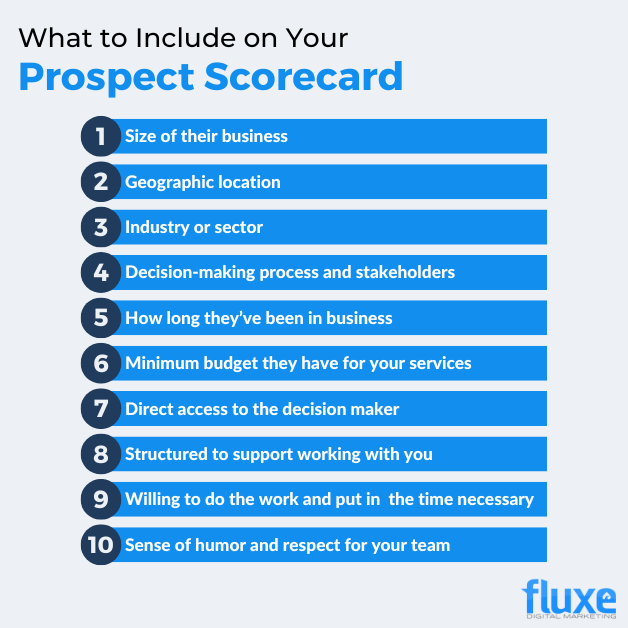For years, my worst enemy was lurking right in my own business: vagueness.
As a B2B business owner, I’m specifically talking about vagueness in terms of prospect management. It wasn’t unusual to find myself on the fence about a particular prospect, or sense that the “vibes were off,” but I couldn’t always articulate why.
Once I identified the problem, I finally put pen to paper and wrote my own prospect scorecard. It’s a list of criteria I use to separate A-grade clients from B-grade clients from F-grade clients. It’s saved me a ton of time and energy, and I even encourage my B2B clients to create their own.
Want to know how a prospect scorecard can help your business identify best-fit buyers, too? Read on.
Why You Need a Prospect Scorecard
A prospect scorecard is a linchpin with a trickle-down effect throughout your entire company. For example, you can’t scale your marketing if your sales engine isn’t in place. Otherwise, you’re just adding unqualified leads to a leaky prospect funnel.
Ultimately, a business without a prospect scorecard (which, for many years, was my own) suffers from:
Poor use of resources. Without well-defined prospect criteria, a business typically ends up wasting time and resources pursuing potential customers who just aren’t a good fit for the company’s products or services. This also means missing opportunities to engage with more promising prospects.
Ineffective marketing and sales efforts. Without clear prospect criteria, a business can struggle to create marketing and sales messages that resonate with potential customers. This leads to low conversion rates and a lack of interest in the company’s products or services.
Misaligned business goals and objectives. Without a prospect scorecard, a business’s goals and objectives may not align with the needs and preferences of its potential customers. This results in a lack of focus and direction and, ultimately, a lack of success.
Limited growth and revenue. A business that struggles to identify and engage with the right potential customers can suffer limited growth and revenue. They may miss out on opportunities to sell their products and services to a larger and more diverse customer base.
An inability to compete effectively. Similarly, a business with vague or no target prospect criteria can find it difficult to differentiate themselves from others in their industry and stand out in a crowded marketplace.
How to Identify Key Criteria for Evaluating Potential Customers
This brings us to a practical exercise: developing a prospect scorecard that’ll weed out prospects who aren’t a great fit so you can spend more time on the ones who are.
At the end of this exercise, you should walk away with a simple top-10 list of target client criteria you can use alongside your target buyer persona, sales processes, and marketing campaigns. (Check out our Fluxe Marketing Scorecard for help with clarifying your marketing approach.)
To be clear, a prospect scorecard shouldn’t replace processes you already have. Rather, it’s a good starting point to help sharpen your focus by simplifying the prospect management process.
When you finish this exercise, these two things should be true:
- Your list isn’t longer than 10 criteria. You’ll probably have more, but the goal is to force you to prioritize. If you have more, you can add them to a queue to evaluate later with your team.
- The criteria are polarizing and answered with a yes or a no. Your goal is to make it easy for you to quickly grade your prospects. If you add sliding scales to this, you create room for interpretation (and vagueness) and start second-guessing yourself.
You’ll come away with a list of what’s working today, but keep in mind that this list will evolve as you grow. Don’t pressure yourself to make it perfect — perfect is the enemy of done. Like my friend Tom says, “Make a plan so you can change it.” Your approach will change and evolve, but the goal is to get something down now.
Find Your Prospect Scorecard Criteria
Not sure where to start? Past and current clients are your best resources.
Kick off this exercise by considering your best clients. What traits do they have in common? Are they a great culture fit? Do they pay on time? Answer emails promptly? Respect your team?
Now do the same for your worst clients. What do they have in common? What do you know absolutely won’t work? What do you need to say no to?
Below are some examples of the types of criteria you might include for your prospect scorecard:
- Size of their business
- Geographic location
- Industry or sector
- Decision-making process and stakeholders
- How long they’ve been in business
- Minimum budget they have for your services
- Direct access to the decision maker
- Structured to support working with you (e.g., they have a documented sales process and account managers in place)
- Willing to do the work and put in the time necessary
- Sense of humor and respect for your team

The Scoring System
Once you determine the top 10 criteria for your prospect scorecard, you can move on to creating a scoring system. Here’s how ours looks (and yes, it’s ridiculously simple):
- If a prospect meets 8–10 criteria, they’re an A.
- If a prospect meets 5–7 criteria, they’re a B — still aligned with our values, but not as much of a priority as an A.
- Anything below a 4 isn’t worth your time.
This works for us, but everyone’s different. Your criteria will be unique to your business, and only you can determine where A-level and B-level (and below) prospects fall on the scale.
You may also weight certain criteria over others, which is completely fine. For example, if a client isn’t a good culture fit for us, we know without looking at anything else that they won’t be a good fit overall. Again, your scoring is completely up to you.
Regardless of what you decide, take some time to play with your prospect scorecard and test it in action. Remember: The primary goal of this exercise is to have a framework in place that’s black and white so you don’t second-guess yourself.
Put Your Prospect Scorecard to Work
The last step in creating a prospect scorecard is to just start using it!
Share the scorecard with your team and get them involved, especially your sales department and anyone with a hand in client management. Help them understand the why behind the scorecard and how to evaluate prospects according to the criteria.
Bottom line: Your prospect scorecard should be a useful tool to help prioritize which potential customers to pursue and which to ignore. The sooner you start using it, the sooner you start to focus your efforts on best-fit clients.
Kill Vagueness With Your Prospect Scorecard Now
I don’t want to see other businesses to suffer through vagueness. As a B2B business owner, you can’t create a prospect scorecard fast enough.
Once you develop your own list of criteria to identify and target your most promising potential customers, your entire team will save time and energy, your sales and marketing will become more effective, and you’ll see an uptick in revenue.
The best time to create a prospect scorecard is yesterday — but the second best time is right now!



